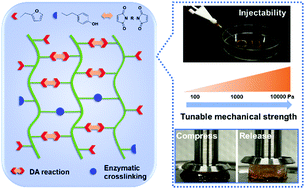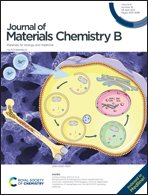Injectable poly(γ-glutamic acid)-based biodegradable hydrogels with tunable gelation rate and mechanical strength†
Abstract
Polypeptide-based hydrogels have potential applications in polymer therapeutics and regenerative medicine. However, designing reliable polypeptide-based hydrogels with a rapid injection time and controllable stiffness for clinical applications remains a challenge. Herein, a class of injectable poly(γ-glutamic acid) (PGA)-based hydrogels were constructed using furfurylamine and tyramine-modified PGA (PGA–Fa–Tyr) and the crosslinker dimaleimide poly(ethylene glycol) (MAL–PEG–MAL), through a facile strategy combining enzymatic crosslinking and Diels–Alder (DA) reaction. The injectable hydrogels could be quickly gelatinized and the gelation time, ranging from 10 to 95 s, could be controlled by varying the hydrogen peroxide (H2O2) concentration. Compared with hydrogels formed by single enzymatic crosslinking, the compressive stress and strain of the injectable hydrogels were remarkably enhanced because of the occurrence of the subsequent DA reaction in the hydrogels, suggesting the DA network imparted an outstanding toughening effect on the hydrogels. Furthermore, the mechanical strength, swelling ratio, pore size, and degradation behavior of the injectable hydrogels could be easily controlled by changing the molar ratios of H2O2/Tyr or furan/maleimide. More importantly, injectable hydrogels encapsulating bovine serum albumin exhibited sustained release behavior. Thus, the developed hydrogels hold great potential for applications in biomedical fields, such as tissue engineering and cell/drug delivery.



 Please wait while we load your content...
Please wait while we load your content...